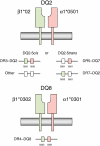Translational mini-review series on the immunogenetics of gut disease: immunogenetics of coeliac disease
- PMID: 18713140
- PMCID: PMC2492906
- DOI: 10.1111/j.1365-2249.2008.03704.x
Translational mini-review series on the immunogenetics of gut disease: immunogenetics of coeliac disease
Abstract
Recent advances in immunological and genetic research in coeliac disease provide new and complementary insights into the immune response driving this chronic intestinal inflammatory disorder. Both approaches confirm the central importance of T cell-mediated immune responses to disease pathogenesis and have further begun to highlight other relevant components of the mucosal immune system, including innate immunity and the control of lymphocyte trafficking to the mucosa. In the last year, the first genome wide association study in celiac disease led to the identification of multiple new risk variants. These risk regions implicate genes involved in the immune system. Overlap with autoimmune diseases is striking with several of these regions being shown to confer susceptibility to other chronic immune-mediated diseases, particularly type 1 diabetes.
Figures



References
-
- Accomando S, Cataldo F. The global village of celiac disease. Dig Liver Dis. 2004;36:492–8. - PubMed
Publication types
MeSH terms
Substances
Grants and funding
LinkOut - more resources
Full Text Sources
Medical

